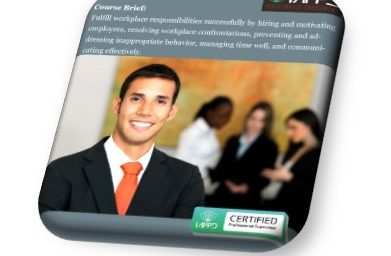Certified Professional SupervisorLearning is a treasure that will follow its owner everywhere. Chinese Proverb
Welcome to the Supervising Others workshop. Supervising others can be a tough job. Between managing your own time and projects, helping your team members solve problems and complete tasks, and helping other supervisors, your day can fill up before you know it.
This workshop will help supervisors become more efficient. They will also become more proficient with delegating, managing time, setting goals and expectations (for themselves and others), providing feedback, resolving conflict, and administering discipline.
Welcome to the Supervising Others workshop. Supervising others can be a tough job. Between managing your own time and projects, helping your team members solve problems and complete tasks, and helping other supervisors, your day can fill up before you know it. This workshop will help supervisors become more efficient. They will also become more proficient with delegating, managing time, setting goals and expectations (for themselves and others), providing feedback, resolving conflict, and administering discipline.
Types of Work Assignments
- Orders: These leave no room for guesswork, and they typically match the dictatorial approach discussed below. These should only be used for emergencies. Example: “Shut off that tap, now!”
- Requests: These types of assignments leave the employee some room for interpretation. These are the work descriptions you will want to use most often. Example: “John, please turn off that water.”
- Suggestions: These types of work assignments leave the most room for interpretation and should only be used if you don’t care how the work gets done, or if it’s a low priority task. Example: “Susan, it would be nice if we could come up with a different format for that report.”
A Survival Guide for the New Supervisor
Ask the Right Questions of the Right People
This means that if you have a question about front-line activities, go to the frontline workers. Or, for questions about payroll, you would talk to human resources.
Go to Gemba
“Going to gemba” means going to the place where the action is happening. If you want to see how invoices are processed, go to the accounting department and watch the process yourself.
Keep Learning!
Start small, but aim big. Set goals for yourself and keep working towards them. Training doesn’t have to take place in the classroom. Try listening to your staff and colleagues, reading books and journals, and watching educational videos, are all excellent ways to learn more and keep improving yourself.
Methods of Work Assignment
- The easiest short-term work assignment method is to simply assign tasks to individuals.
- However, this generates the least job satisfaction and independence.
- This method should be used when a task needs to be completed urgently, or if it is a task that no one wants to take on.
- For best results, make sure that you explain the importance of the task and the rewards to the individual, the department, and the organization.
- This method gives employees more freedom in choosing their tasks, although it does not emphasize team problem solving or collaboration.
- The basic idea is that the team member chooses a project that they would like to work on from a list of departmental tasks.
- This is a good method to use when there is a small group of tasks to be assigned, a very small group of employees, and not enough time for a meeting. In this case, make sure that the tasks are equal in value and workload.
- This method can also be used when the department has a list of low-priority “fillers” and an employee needs a short term project.
- Be careful when using this method if there are just as many tasks as people.
The Collaborative Approach
- With this method, the team has a meeting to decide who completes which task.
- This method will enable you to get more out of your employees and to help them grow and develop.
- However, this method is not appropriate for a list of menial tasks, or if a task needs to be urgently completed.
- It is most effective when used with a mature team (a team that has worked together for 6 months or more).
The Urgent-Important Matrix
- This concept is said to be how former US President Dwight Eisenhower organized his tasks. It was brought into the mainstream by Stephen Covey.
- Urgent And Important: Activities in this area relate to dealing with critical issues as they arise and meeting significant commitments. Perform these duties now.
- Important, But Not Urgent: These success-oriented tasks are critical to achieving goals. Plan to do these tasks next.
- Urgent, But Not Important: These chores do not move you forward toward your own goals. Manage by delaying them, cutting them short, and rejecting requests from others. Postpone these chores.
- Not Urgent And Not Important: These trivial interruptions are just a distraction, and should be avoided if possible. However, be careful not to mislabel things like time with family and recreational activities as not important. Avoid these distractions altogether.



